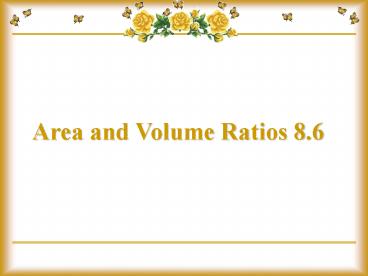Area - PowerPoint PPT Presentation
1 / 16
Title:
Area
Description:
Area and Volume Ratios 8.6 Define similar solids. homework Learn the perimeter, area, and volume ratios of similar solids. Use the ratios to find missing measurements ... – PowerPoint PPT presentation
Number of Views:153
Avg rating:3.0/5.0
Title: Area
1
Area and Volume Ratios 8.6
2
- Define similar solids.
- Learn the perimeter, area, and volume ratios of
similar solids.
- Use the ratios to find missing measurements.
3
Similar solids are solids that have the same
shape but are not necessarily the same size. Just
as with similar polygons, corresponding linear
measures have equivalent ratios.
4
(No Transcript)
5
(No Transcript)
6
Proportional Angle Bisector Theorem
7
Proportional Altitudes Theorem
- A
- B
- C
- D
8
Proportional Medians Theorem
9
The solid is similar to a larger solid with the
given scale factor. Find the surface area S and
volume V of the larger solid.
10
Use the given information about the two similar
solids to find their scale factor.
11
The scale factor of the model car at the right to
the actual car is 116. Use the scale factor to
complete the exercises.
- The model has a height of 5.5 inches.
- What is the height of the actual car?
- b. Each tire of the model has a surface area
- of 12.9 square inches. What is the surface
- area of each tire of the actual car?
- c. The models engine has a volume
- of 2 cubic inches. Find the volume of
- the actual cars engine.
12
You are given two similar solids. Find the
missing measurement. Then calculate the surface
area and volume of each solid.
13
ABC Lumber Company sells plans and materials for
several storage sheds. The two designs shown have
a similar shape, but differ in size. a. Find
the scale factor of the shed on the left to the
shed on the right. b. Find the ratios of the
surface areas and the volumes.
14
Softballs and baseballs are both used to play a
game with a bat. A softball has a diameter or 3.8
inches, while a baseball has a diameter of about
2.9 inches. Find the scale factor of the two
balls.
Write the ratio of the corresponding measures of
the balls.
Answer The scale factor is about 1.31.
15
Two sizes of balloons are being used for
decorating at a party. When fully inflated, the
balloons are spheres. The first balloon has a
diameter of 18 inches while the second balloon
has a radius of 7 inches..
a. Find the scale factor of the two
balloons. b. Find the ratio of the surface
areas of the two balloons. c. Find the ratio of
the volumes of the two balloons.
97
8149
729343
16
Assignment
8.6 Area, Length, and Volume Ratios





























![Area and Volume [I] PowerPoint PPT Presentation](https://s3.amazonaws.com/images.powershow.com/7947695.th0.jpg?_=20160702019)

